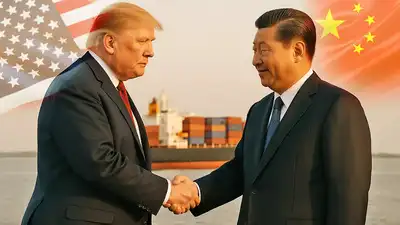Chapter 1:Gross Domestic Product (GDP)
The United States’ Gross Domestic Product (GDP) for the year 2024 was approximately $29.72 trillion.

In the fourth quarter of 2024, the U.S. economy experienced an annualized growth rate of 2.4%, slightly revised upwards from earlier estimates. This growth was primarily driven by a significant increase in consumer spending, which rose by 4.0% during the same period.
Although a decline in investment somewhat offset this gain, increases in government and consumer spending were the main drivers of this expansion.
However, projections for 2025 show a decrease in economic growth because of a number of issues, such as the effect of tariffs and policy uncertainty.
Policy Uncertainty and Tariffs in the U.S.
The term “policy uncertainty” describes the unpredictability of governmental policies, such as trade agreements, monetary policy, taxes, and regulations. This uncertainty impacts consumers, businesses, and investors in the United States, impacting financial markets and economic growth.
Key Causes of Policy Uncertainty in the US
Trade Policies & Tariffs:
A tariff is a tax imposed by a government on imported goods. The U.S. has used tariffs as a tool for economic policy, especially in trade disputes with major partners like China, the EU, and Mexico.
Recent Examples of U.S. Tariffs:
-
China Trade War (2018-2020): High tariffs on Chinese imports led to retaliatory tariffs, affecting American farmers and manufacturers.
-
Automobile Tariffs (2024): A new 25% tariff on foreign cars raised concerns about consumer costs and economic slowdown.
The Pros of Tariffs
- shields home businesses from outside rivalry.
- promotes the establishment of jobs and local manufacturers.
- raises the amount of money collected by the government.
The Cons of Tariffs
-
Raises prices for consumers and businesses.
-
Can lead to trade wars, reducing global economic growth.
-
Hurts industries reliant on imported materials (e.g., tech and auto sectors).
Types of Trade Policies

Policy of Free Trade
- promotes minimally restricted, unrestricted trade between nations.
- promotes international economic cooperation by lowering trade restrictions and tariffs.
- For instance, numerous trade restrictions between the United States, Canada, and Mexico were removed by the North American Free Trade Agreement (NAFTA), which is now known as the USMCA.
Protectionist Trade Policy
-
Imposes tariffs, quotas, and restrictions to protect domestic industries.
-
Can limit foreign competition but may increase consumer prices.
-
Example: The U.S.-China trade war resulted in high tariffs on imported goods to support American industries.
Policy for Fair Trade
-
Aims to ensure ethical and sustainable trade practices.
-
Focuses on labor rights, environmental standards, and reducing exploitation in developing countries.
-
Example: The U.S. imposes restrictions on goods made using forced labor.
Bilateral & Multilateral Trade Agreements:
A bilateral trade agreement is a trade deal between two countries that sets specific terms for trade, investment, and economic cooperation. These agreements aim to promote commerce by reducing tariffs and trade restrictions between the two nations.
U.S. Bilateral Trade Agreements:
-
U.S.-Japan Trade Agreement (2019)
-
Reduced tariffs on U.S. agricultural products exported to Japan.
-
Lowered Japanese tariffs on beef, pork, and wheat from the U.S.
-
Increased digital trade cooperation between both nations.
-
-
U.S.-South Korea Free Trade Agreement (KORUS, 2012; Revised 2018)
-
Eliminated tariffs on 95% of U.S. consumer and industrial exports to South Korea.
-
Strengthened protections for U.S. intellectual property.
-
Revised in 2018 to give more access to U.S. auto manufacturers.
-
-
U.S.-China “Phase One” Trade Deal (2020)
-
China agreed to buy $200 billion worth of U.S. goods, including agricultural products.
-
Intellectual property protections were strengthened.
-
Some tariffs remained in place, leading to continued tensions.
-
A multilateral trade agreement is a trade deal between three or more countries that establishes common trade rules, reduces barriers, and promotes economic integration. These agreements are more complex but offer broader benefits.
U.S. Multilateral Trade Agreements:
-
United States-Mexico-Canada Agreement (USMCA) – 2020 (Replaced NAFTA)
-
Updated labor and environmental protections.
-
Increased North American content requirements for automobiles.
-
Strengthened intellectual property rights.
-
-
World Trade Organization (WTO) Agreements
-
The U.S. is a member of the WTO, which oversees global trade rules.
-
The WTO agreements reduce trade barriers among its 164 member countries.
-
-
Trans-Pacific Partnership (TPP) – U.S. Withdrew in 2017
-
Originally included 12 Pacific Rim countries.
-
The U.S. withdrew, and the remaining nations formed the Comprehensive and Progressive Agreement for Trans-Pacific Partnership (CPTPP).
-
Forecasts for 2025
| Source | 2025 GDP Growth Forecast | 2026 GDP Growth Forecast |
|---|---|---|
| S&P Global Ratings | 1.9% | 1.9% |
| The Conference Board | 2.0% | 1.7% |
| Morgan Stanley | 1.5% (Q4/Q4) | 1.2% |
| Philadelphia Fed Survey | 2.4% (annual average) | Not specified |
Inflation and Interest Rates
U.S. Federal Reserve Policy (2022-2024)
-
2022-2023: Inflation surged to over 8% due to supply chain issues and stimulus spending. The Fed increased interest rates aggressively to control inflation.
-
2024: Inflation slowed to around 3-4%, and the Fed paused rate hikes to avoid a recession.
Current U.S. Inflation and Interest Rate Trends (2025)
-
Inflation: Around 3.2%, slightly above the Fed’s 2% target.
-
Interest Rates: The Fed’s benchmark rate remains at 5.25%-5.50%, with expectations of possible rate cuts if economic growth slows further.
Labor Market and Unemployment: An Overview
The labor market refers to the supply of workers and the demand for jobs in an economy. It is influenced by economic conditions, government policies, and technological changes. Unemployment measures the percentage of people actively looking for work but unable to find jobs.
U.S. Labor Market & Unemployment Trends (2025)
📌 Current U.S. Unemployment Rate (2025): 3.9% (near historic lows but slightly rising).
📌 Job Growth: Slower than in 2023-2024, with hiring cooling in tech and finance sectors.
📌 Wages: Wage growth remains steady, but inflation-adjusted wages are a concern.
📌 Labor Force Participation Rate: Around 62.5%, meaning some workers are still not returning to the workforce post-pandemic.
Challenges in 2025:
⚠️ Layoffs in Tech & Finance due to economic uncertainty.
⚠️ Shortages in Skilled Labor for manufacturing, healthcare, and AI-related jobs.
⚠️ AI & Automation Impact on traditional jobs.
Government Policies to Manage Unemployment
✔ Federal Reserve’s Role: Adjusts interest rates to manage job growth and inflation.
✔ Job Training Programs: Helps workers gain new skills in high-demand fields.
✔ Unemployment Benefits: Provides temporary financial support to job seekers.
✔ Minimum Wage Laws: Affects labor costs and employment levels.



